Snapshots from 1933
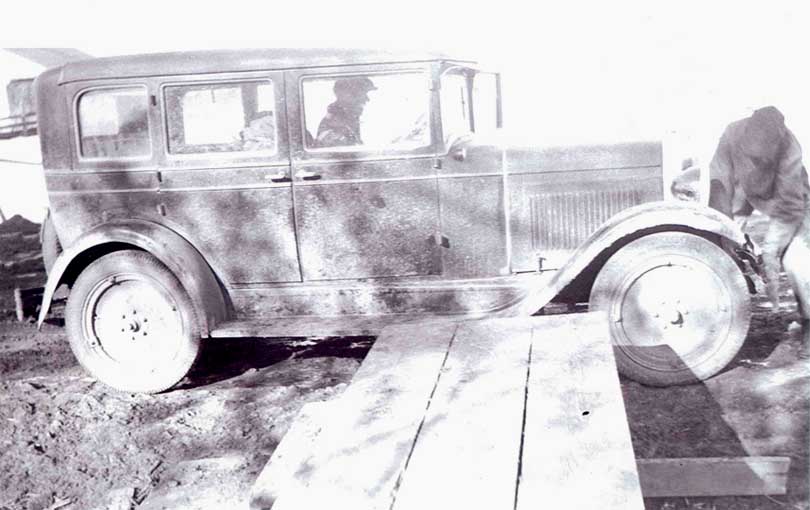
Introduction
The 1930s were a difficult time for Iowans and most other Americans. The Great Depression affected just about everyone. Agricultural prices were down. Jobs were scarce. The weather was devastating. Many people perceived that anything beyond the basic levels of education was a luxury. The Iowa State Teachers College, now the University of Northern Iowa, certainly experienced the effects of the Depression. In 1929, ISTC enrollment was 2227. By 1932, enrollment had dropped to 1562. And by 1933 it had dropped to 1472, a 34% decrease in four years. Tuition at that time was $20-$30 per term. Enrollment at ISTC would not sink that low again until World War II, when many men and women were in military or home front service.
George Leroy Blumer attended the Iowa State Teachers College in 1932-1933. In 2010, his daughter, Ruth Buchholz donated a small collection of photographs that her father had taken during his brief time at the college. Those photographs provide a snapshot of his life during that time. They show that a student, even in difficult economic times, could still have fun with friends and show an interest in the world around him. Most of the photographs in this essay come from that collection.
Getting Started at the Teachers College
George Leroy Blumer was always known by his middle name, Leroy. He was the third child of a family of nine from Ottumwa, Iowa. His daughter, Ruth Buchholz, says that her father never met a stranger. He was friendly and had a great sense of humor. Her characterization of his manner seems to be borne out in some of the pictures in this collection.

Leroy Bloomer graduated from Blakesburg High School in 1932. He did not enroll at the Iowa State Teachers College in the fall term immediately after his graduation. Instead, he enrolled for the winter term, 1932-1933. In those days the school year was divided into four terms: fall, winter, spring, and summer. The 1932-1933 winter term began with registration on Monday, November 29, 1932, just after Thanksgiving weekend. Registration for the 1932 fall term had included an address by President Latham, a Student Council reception, and lectures by Dean of Men Leslie Reed and Dean of Women Sadie Campbell. Students such as Leroy Blumer, who were new to the campus at the start of the winter term, would have had more limited opportunities to learn about the college or to get acquainted with fellow students. For Leroy Blumer, registration would simply have been enrolling in specific classes and paying his fees. Classes began the next day, Tuesday, November 30, 1932. He enrolled in five classes:
- Principles of Elementary Mathematics I
- Drill Music
- Rural School Management
- Applied Physical Education
- English
Even before he registered, though, Leroy Blumer would have had to find a place to live. In 1932, Bartlett Hall served as a dormitory for women. But there was no on-campus residence hall for men. Baker Hall and Seerley Hall for Men would not be built until several years later. So, men usually lived in a fraternity house or found space in one of the many College Hill rooming and boarding houses on the east and north sides of campus. The College Hill neighborhood itself had been developed in the 1890s when the Normal School got out of the rooming and boarding business. Local entrepreneurs then built large houses near campus to meet the need for student housing. Typically, the owner and his or her family lived in one portion of the house and rented extra rooms to students.
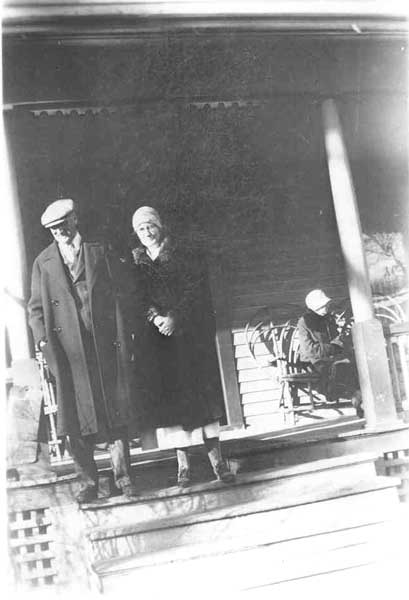
Leroy Blumer found room with Mr. and Mrs. V. R. Barrigar. The Barrigars had operated a rooming house, usually called Barrigar Hall, at 815 W. 22nd Street in the College Hill neighborhood since at least 1920. The Cedar Falls city directory for 1934 states that Mr. Barrigar was a constable, so he almost certainly ran an orderly house. That house was demolished in about 1967 to make way for a city parking lot.
It is unclear now why Leroy Blumer chose to attend the Iowa State Teachers College. At that time, the school had a single purpose: the preparation of teachers. All students took the professional education sequence. So he probably had at least an inclination to become a school teacher. However, many colleges offered teacher training. Why did he choose ISTC? Perhaps he had a relative or a friend in Cedar Falls. Or perhaps ISTC was simply the most affordable school.
In any case, Leroy Blumer had a camera for at least part of his time in Cedar Falls That was not unusual. Students had been bringing their own cameras to campus since about 1900. Leroy Blumer probably had a small box camera that used 120 film. Cameras like that cost just a few dollars and took reasonably good pictures. Processing the exposed eight or twelve images on a roll of film could cost another dollar or so, but taking an occasional photo on a camera like this was a relatively inexpensive way to preserve memories.
Leroy Blumer's Friends
Leroy Blumer used most of his film to photograph friends and housemates. Those photos are all posed and taken outdoors, typically on the front steps of the rooming house. That was a traditional pose for student snapshots of that day. But the shots are also the result of the limitations of Blumer's camera. In order for the camera to take a good picture, people had to stand still in good light. Freezing action or taking indoor shots in reduced light was difficult. And Blumer certainly did not have the luxury of today's digital photographers who can take a hundred shots to get one good one. Once he snapped the shutter, the image was taken. He had no way of knowing how the picture would turn out until he had the film developed.


Leroy Blumer's photos are not as sharp as some of today's images. And, in some cases, the photos are a bit off center or may show some overexposure. But they do offer a nice view of what Teachers College men looked like in those days. It is interesting to note how well-dressed most of the men are. There is no reason to assume that they had dressed up to have their pictures taken. In those days, men students usually wore a jacket or a sweater, nice pants, a dress shirt, and a tie to class. In cold weather, they wore a top coat as their outer wear. The photographs also occasionally furnish a nice little homey detail, like the Barrigar's terrier, in the background.
Harold Freese was from Tripoli, Iowa. Byron Earl Bell was from Toledo, Iowa. Bell majored in English and was a member of the Writers Club. He played tennis and even competed for the Teachers College campus tennis prize, the Haddox Trophy. He graduated with a bachelor's degree in 1935 and died in 1995.
Teale Garard was from Blockton, Iowa. He was a sophomore when Leroy Blumer was on campus. William Pholsgraf was from La Porte City, Iowa.
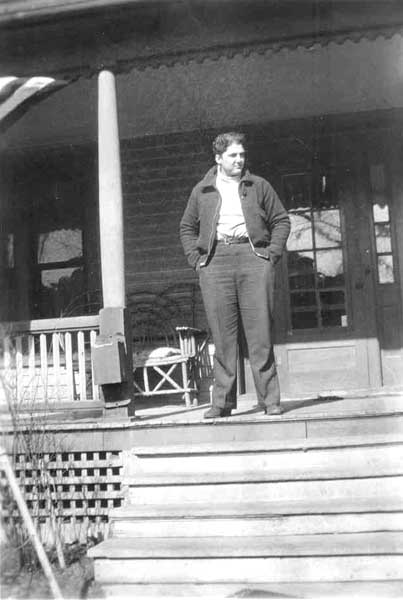
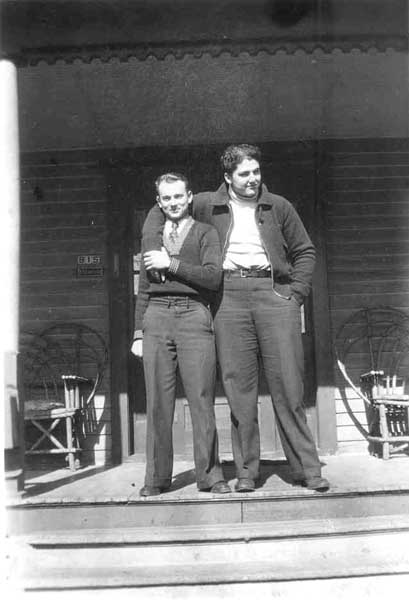
Robert Ruby was from Sheldon, Iowa. Paul W. Beard was from Kalona, Iowa. Beard was a music major like Edward Dirks, pictured below. He was in the Minnesingers glee club, the Marching Band, the College Symphony, and the College Band. He was involved with the activities of the Methodist Student Center. And, like his housemate Byron Bell, pictured above, he played tennis. He graduated in 1936 and returned for his golden class reunion in 1986. He died in 1996.
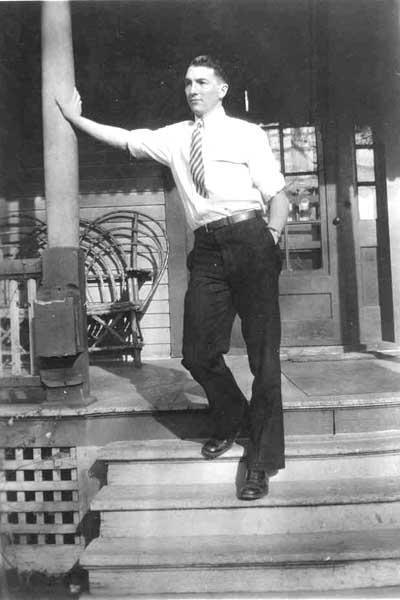
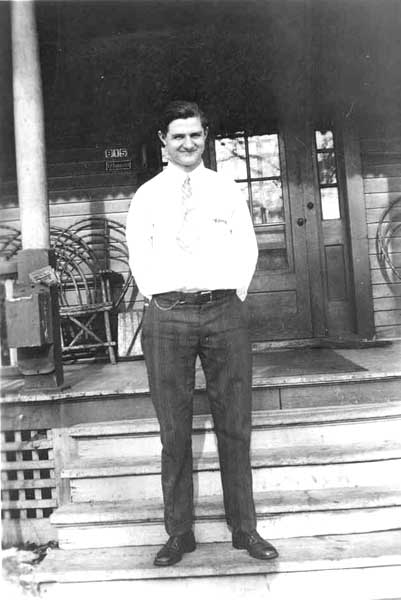
Sterling Tomlinson was from Reinbeck, Iowa. Julian Torrano was from Santo Domingo in the Philippine Islands. That was truly an exotic and exceptional place of origin for a Teachers College student of those days. It is interesting to speculate whether or not Torrano had difficulty in obtaining housing at a time when attitudes about discrimination were less enlightened than they are now. Torrano had been in the United States for four years when he arrived at the Teachers College in 1929. He chose to attend the Teachers College because it was one of five teacher training institutions in the United States whose work was accepted by the Philippine government. While Torrano was a student at the Teachers College, the student newspaper ran several feature articles about him and Philippine customs. He was still in school as late as August 1932, but he did not receive a degree.
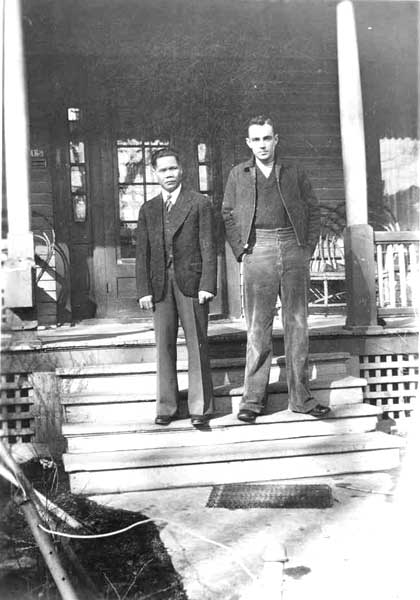
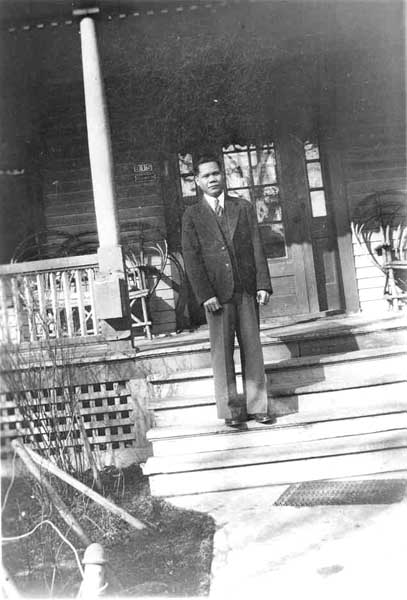
Varner Franklin was from Diagonal, Iowa. Luther Dokken was from Linn Grove, Iowa. James H. Gaffey was from Riceville, Iowa. He later joined Xanho fraternity, but did not receive a degree from Teachers College. Edward Dirks was from Dike, Iowa. His academic and avocational interests were centered around music, similar to those of his housemate, Paul Beard, pictured above. He was in the Minnesingers glee club, the Marching Band, and the College Symphony. He was a member and officer of the Phi Mu Alpha Sinfonia music honorary society. He received his degree in 1936 and then took a job teaching music. He married and had a son, but he died shortly afterward in 1938.

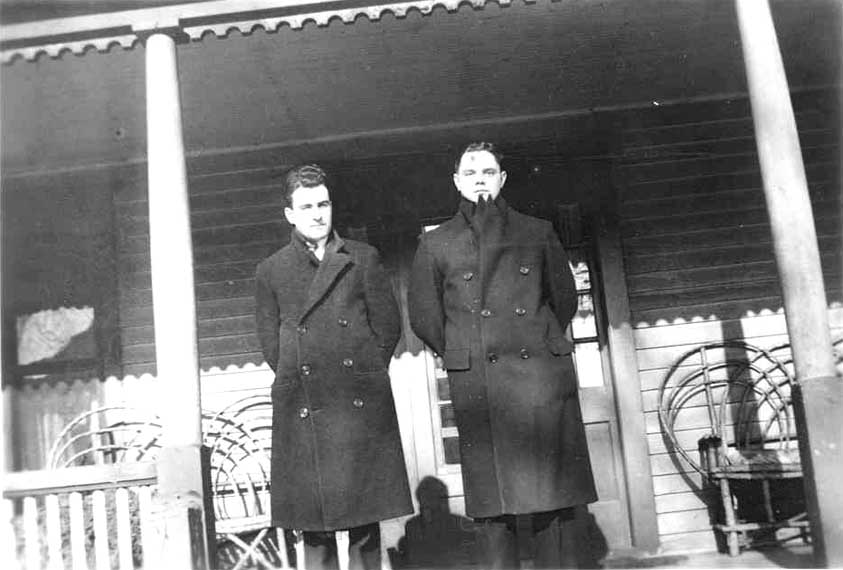
Glenn Albro studied chemistry at the Teachers College. Raymond Howard Smalling was from Janesville, Iowa. Smalling was an excellent athlete, who participated in football, basketball, baseball, and track. He received his bachelor's degree from the Teachers College in 1935. His background in athletics then helped him to find teaching positions with coaching responsibilities. After completing a master's degree at the University of Iowa in 1940, he served in the United State Navy during World War II, where he rose to the rank of Lieutenant Commander. After the war, he returned his coaching and teaching career. He died in 2001.
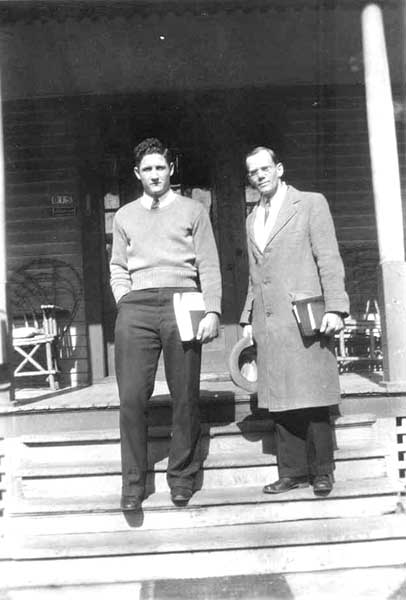
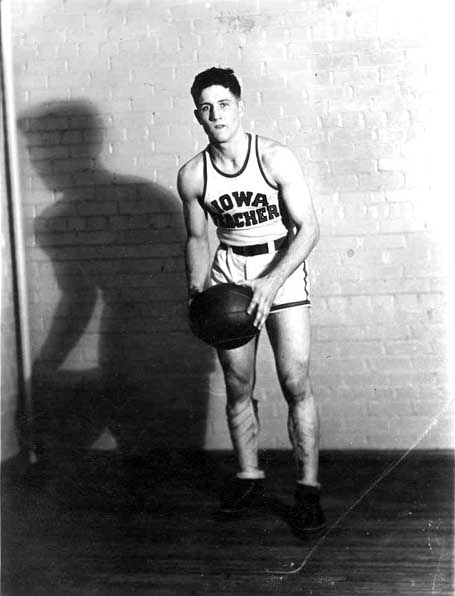
Harold Mikes was from West Bend, Iowa. Joseph Sadoff, pictured outside of what was then the Library, but is now Seerley Hall, was from Clarion, Iowa.
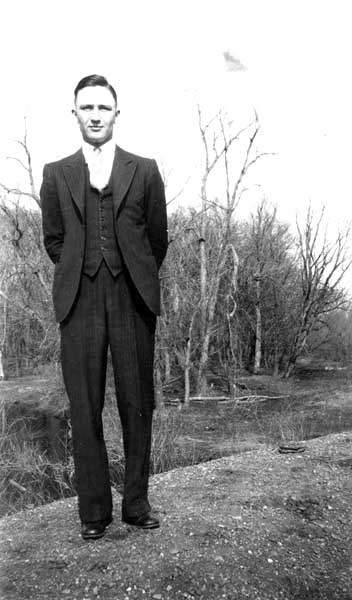
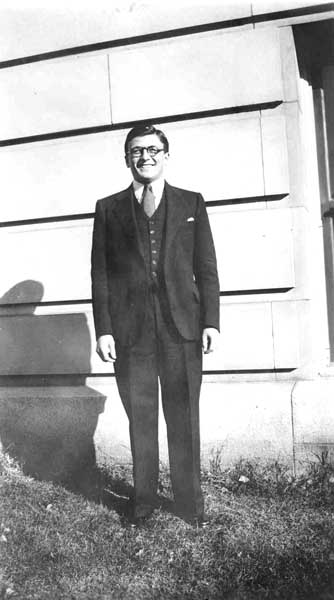
Randall R. Bebb was from Conesville, Iowa. He left school before he completed his degree and went back to Conesville to teach. That was common in those days when a college degree was not required to get a teaching position. But he did return to the Teachers College and received his degree in 1942. After service in the Signal Corps during World War II, he joined the faculty of the Teachers College Laboratory School in 1947. He remained on the education faculty until his retirement in 1981. He died in 2001.
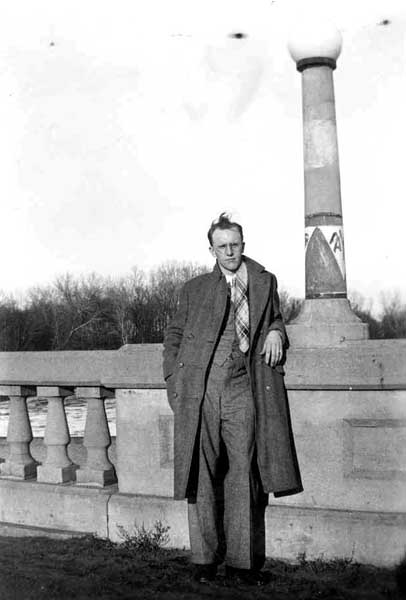
We do not know at this point exactly how Leroy Blumer spent his time while enrolled at the Teachers College. He attended class, of course. And he worked. His daughter Ruth Buchholz recalls that he said that he shucked corn by hand while he was in college. For a full day's work, he earned $1. If he had time for anything else, he might have attended some athletic events. The football season had just concluded when he arrived on campus. But basketball was about to begin. One of Leroy Blumer's housemates, Ray Smalling, was on the Panther basketball team, so there is a good chance that Blumer went to a game or two. The Panther basketball team played well in 1933. They finished second in the Iowa Conference with an 8-2 record.
If Leroy Blumer had a taste for higher culture, the scene during the 1933 school year was bleak. For many years, the Teachers College had brought a series of fine performers to campus to entertain students, faculty, and townspeople. During the 1931-1932 school year, for example, the Lecture and Entertainment Committee had brought pianist Jan Paderewski to campus for a performance. In the 1932-1933 school year the committee had scheduled internationally renowned violinist Fritz Kreisler and the celebrated soprano Maria Jeritza. But both performances were canceled due to what the newspaper termed "the present financial conditions" of the Teachers College.
Perhaps Leroy Blumer liked to dance. If so, there were plenty of opportunities. Social dancing was an extremely popular form of entertainment for students in the 1930s. There seemed to be a dance of some sort just about every week. Some of the dances were fancy, dress-up affairs. Some were just informal, recreational pastimes. Admission to the informal dances was sometimes free, or a token amount such as ten cents. The price of admittance to one dance just before Christmas 1932 was a tin of canned food, which would be given to the local relief committee for distribution to the poor. Before he went home for the Christmas break, Leroy Blumer might have attended the 27th annual performance of Handel's Messiah. Professor Charles Fullerton directed this excellent presentation sung by Teachers College faculty and students.
A Walk Around Town
While Leroy Blumer focused his camera mostly on his college friends, he also took an interest in the campus, his neighborhood, and the weather. Construction on the new Commons building probably held the most interest for students of 1933. Until that time, there had not been anything like a student union on campus. Student organizations met in classrooms or faculty offices. Dances were often held in one of the gymnasiums. Students needed to go off-campus for a hamburger and a Coke. The new Commons promised to be wonderful space for student recreation. It would feature radios and phonographs, a soda fountain, nicely-decorated dance floors and lounges, and, in general, a pleasant atmosphere in which to relax or study. Unfortunately for Leroy Blumer, the Commons did not open until a few months after he left school. But he did take this nice shot of the south side of the building in the late winter or early spring of 1933.
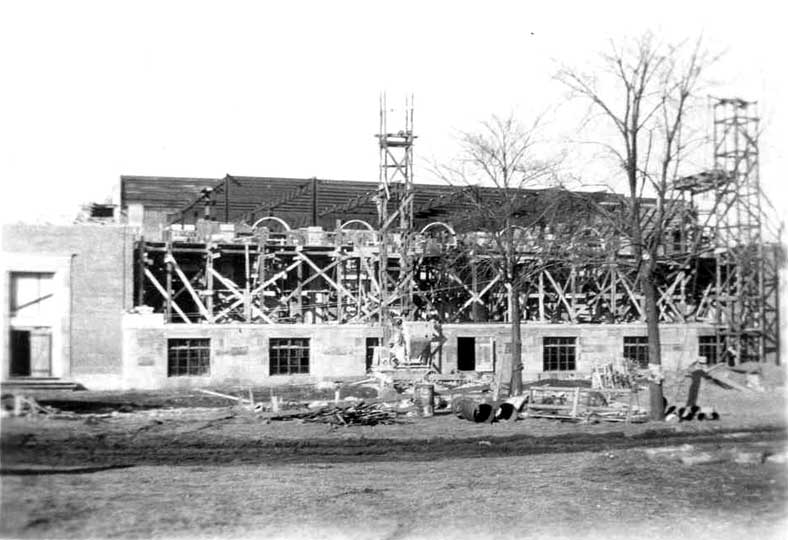
Most students were also familiar with the College Hill business district. Of course, its mix of stores in 1933 was very different from the current mix. In those days, when few students had cars, College Hill offered just about everything that students needed. They could get prepared meals, from sandwiches, to blue-plate specials, to turkey dinners. They could even buy meal plan tickets from some of the little restaurants. They could buy light groceries, such as fruit, bread, peanut butter, crackers, candy, or pastries. They could get their shoes re-soled or repaired. They could buy flowers for their dates. They could buy clothes and dry goods. They could get their pictures taken. And, yes, they could buy textbooks and school supplies. If students wanted a greater variety, and if they had an extra nickel or two in their pockets, they could take the streetcar to downtown Cedar Falls or Waterloo. But for convenience, College Hill could not be beat. Leroy Blumer took this shot from the northeast corner of 23rd and College Streets in 1933. He walked up the Hill along this street every day on his way from his rooming house to class.
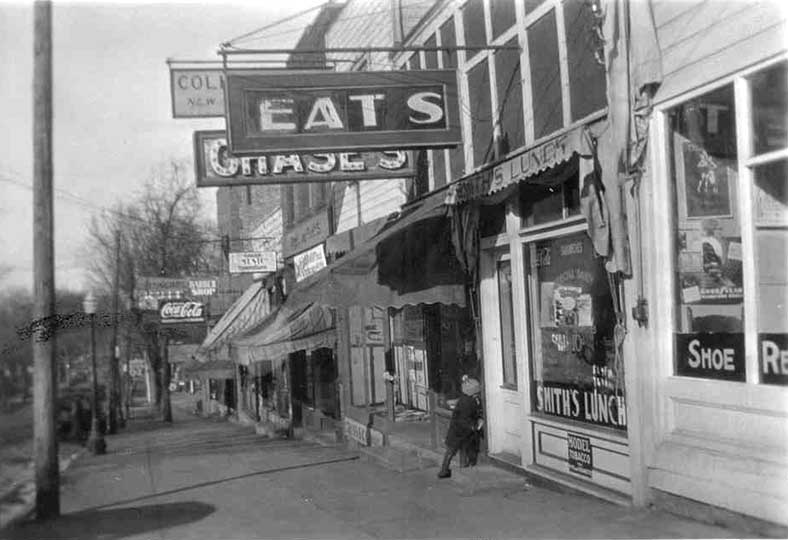
Perhaps one day Leroy Blumer took a walk around his neighborhood. Or maybe he decided to walk to downtown Cedar Falls. One way or the other, he passed what would become a landmark tree at the corner of 18th and Tremont Streets. At some point a homeowner had planted four small linden trees and spliced them together about eight feet off the ground. The trunks then, eventually, grew together to form one tree top. As this tree grew over the years, it became widely known and was frequently photographed.
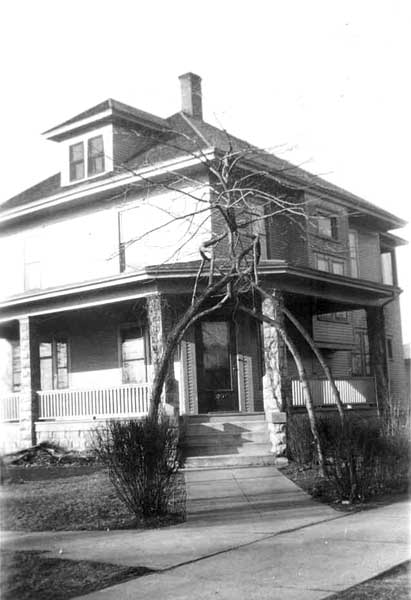
The spliced tree survived until a terrific windstorm roared down 18th Street on July 10, 2009, and snapped off large portions of the upper parts of the tree.
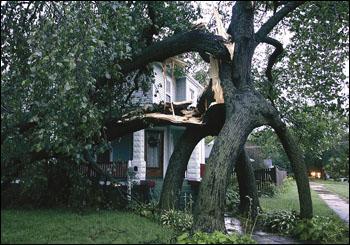
Because so much of the top story of the trees was badly damaged, the homeowner had to have all of the top cut off above the graft. It stands today with just the four trunks and the solid graft. Many people regretted the loss of the grafted tree. There was fairly serious speculation about when the trees had originally been planted. Estimates varied widely, from the 1910s through the 1940s. Proponents of one date or another cited old newspaper articles or neighborhood traditions. This photo by Leroy Blumer, taken in 1933, comes close to settling that question. Given the rapid growth rate of lindens, the trees were probably planted in the middle to late 1920s.
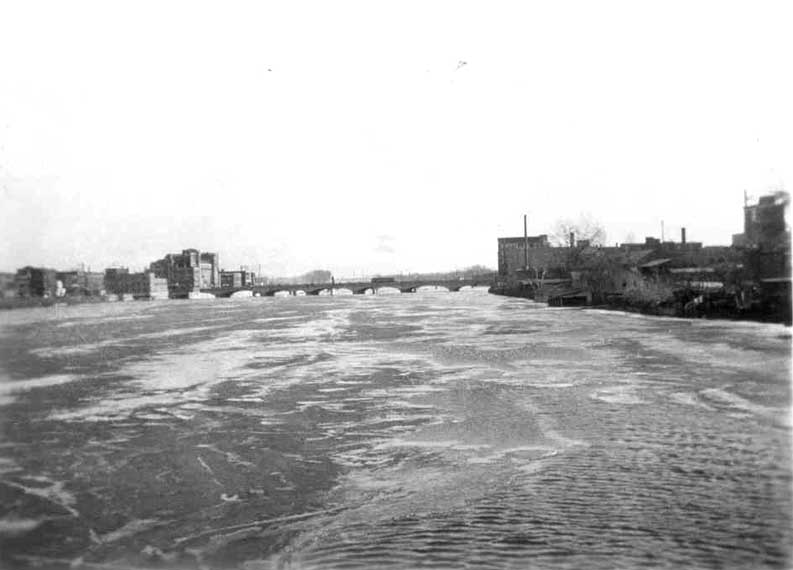

During the early and middle 1930s, the weather in the Midwestern United States was harsh and characterized by extremes. Winters were very cold. Summers were very hot. The spring of 1933 also brought serious flooding to the Cedar River. At the time, the flood of 1933 was the third highest crest ever recorded on the Cedar River. Even today, after the extraordinary floods of 1961, 1993, and 2008, the flood of 1933 is still the sixth worst flood on record on the Cedar River. Leroy Blumer must have taken a walk or a streetcar to see the flood both in Cedar Falls and in Waterloo.
Life After the Teachers College
Leroy Blumer left school at the conclusion of the winter term, March 3, 1933. Since the flood pictures had to have been taken just a bit later than that, he probably stayed around Cedar Falls for several more weeks. It is unclear now why he left school after just one term. Perhaps he ran out of money. Perhaps he found that the prospect of teaching school did not suit him. Or perhaps he was needed at home. He had, after all, initially enrolled for the winter and not the fall term. Perhaps he had had to delay his enrollment until the harvest was complete. And then, in March, perhaps he needed to get back home for planting. But we should also note that Blumer's pattern of attendance was not especially unusual at that time. Teachers did not need a degree in order to teach in public schools. A few terms of college work certainly enhanced a teacher's employment and salary possibilities. But a degree was not necessary. Few students persisted to a four year degree. Of the seventeen men in Leroy Blumer's collection of snapshots, only five received degrees from the Teachers College.
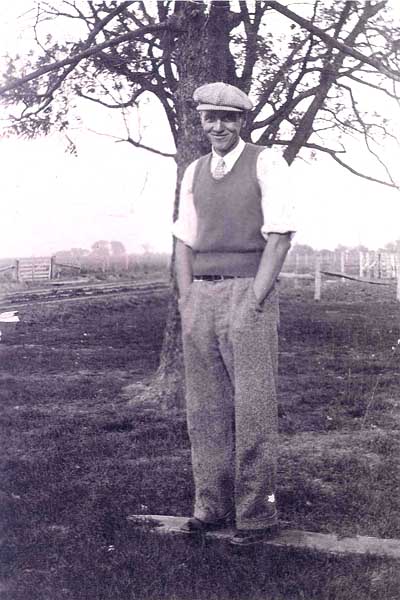
Leroy Blumer returned home and was married in December 1934. He and his wife had four children, two daughters and two sons. Despite his time at the Teachers College, Leroy Blumer did not end up teaching school. Instead, he worked as a butcher for most of his life. During the 1950s he owned a grocery store and a gas station. Later he moved to California where he worked as a butcher in military commissaries. After similar work in Minnesota and Arizona, he retired to Ottumwa, where he died in 1986.
Had Leroy Blumer's time at the Teachers College been wasted? If we can make a judgment based on his snapshots, the answer is probably "No". 1933 was a very tough year. Money was about as tight as it could be. And there were few opportunities to earn even small amounts of cash. Farmers were unable to bring crops to market because they could not come close to recouping costs of production. Many people lost their homes and their land because they could not pay their mortgages. And the weather was often very bad. But Leroy Blumer apparently made good friends while he was at the Teachers College. The young men in his snapshots look reasonably happy and healthy. If they had to skip a meal or two in order to be able to stay in college, they probably considered it just to be part of the price of an education.
Perhaps Leroy Blumer knew that he would be unable to stay long in Cedar Falls. But he wanted to remember his friends, so he took their pictures. And he wanted to remember his surroundings, so he walked around town and took more pictures. It was, to some extent, a 1933 version of Facebook. But in one important way, his photographs are much better than Facebook. The images on Facebook are transient; few will be available for more than a couple of years. But Leroy Blumer took tangible photographs, which he and his family treasured for over seventy-five years, and which the University Archives will now preserve into the foreseeable future.
Essay by University Archivist Gerald L. Peterson, with information and most images provided by Ruth Buchholz; records verification by Registrar Office Coordinator Irene Elbert; research by Student Assistant Dylan Mulfinger; scanning by Library Assistant David Glime; February 2011; last updated October 9, 2014 (GP).
